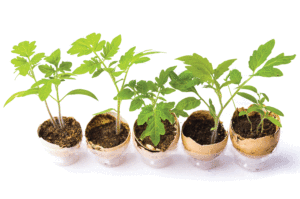Starting seeds indoors in the early spring allows the home gardener the chance to try many varieties of plants with the smallest amount of money.
Buying a few different variety seed packages of lettuce, tomatoes, cucumbers, beans, annual herbs and flowers can provide a full garden by planting only a few seeds of each variety and saving the seeds that become the new favorites for next year. 
Another way to save money and also help the garden vegetables is to plant the seeds inside of egg shells instead of purchasing peat pots or other special pots for seedlings.
The egg shells are made up of calcium and many vegetables, including tomatoes, need calcium for better fruit set and fruit growth.
Planting the seedlings grown in egg shells into the garden will allow the egg shells to decompose and gradually release the calcium for future vegetable.
Break the eggs in half and remove the edible eggs for cooking or baking, then rinse out the inside of each shell.
Place a crumbled paper towel for support inside the shell and poke a small hole in the bottom of the egg shell with a paper clip to allow drainage for the egg shell container.
With a marker, add happy or silly faces to the egg shell and add the names of the vegetables, herbs and flowers.
Add water to a new sterile seed starter potting mix until moist, mixing with a spoon or with your hands.
Lightly fill the egg shells with the moist seed starter potting mix.
It is important to remember that roots need air to breathe, so don’t press down on the potting mix, keep it light and fluffy.
When each egg shell is filled, place it into the egg carton so it will not roll or fall over and spill the potting mix.
Carefully add three to five seeds per egg shell container and using a mister, lightly water the seeds into the soil.
Some seeds grow best if they are on top of the soil and some need a little bit of soil on top of the seeds.
The seed package will give those directions.
Once the egg shell containers have been filled with potting soil and seeds have been added and misted, place a light layer of plastic wrap over the egg shell containers.
Place the egg container on top of the refrigerator to allow the heat of the refrigerator to heat the potting soil.
Check the seeds each day to see if the potting mix is dry and needs to be misted and to see if any of the seeds have become seedlings.
Once the seedlings start to grow, take the egg container off of the top of the refrigerator and place in a full sun window or under a grow light.
The more sun the seedlings have, the better they will grow.
If they are placed in the window they will grow towards the window where the light is, and should be turned around each day to grow more evenly.
If they are grown under a grow light, the light should be dropped to almost 2 inches away from the seedlings.
The first leaves are not true leaves but cotyledons, and the energy inside the cotyledons are used by the seedlings to grow strong roots and begin to grow true leaves.
After the first true leaves start to grow, it is time to pick the strongest seedling and trim out the others, giving the strongest seedling room for the roots and the tops to grow without crowding.
By the time the seedlings have four to eight new leaves it is time to plant them into larger containers or outside in the garden.
Plants that don’t mind cool temperatures like lettuce, beets, broccoli, carrots, chard and spinach can be planted in outside in the garden in April.
Plants that like warm temperatures like cantaloupe, cucumbers, beans, tomatoes and squash need to wait until May, after the last frost, when the soil warms up before being planted outside in the garden.
If the seedlings are to be planted outside, place them outside on a warm day in a sheltered spot out of direct light, and bring them inside in the evening.
The second day, place them in an area with morning sun out of the winds, and bring them back inside in the evening.
In three or four days, the plants will have become used to the outside and can be planted into the garden.
Before planting them into the garden, take the egg shell container with the seedlings and carefully squeeze the egg shell until there are a lot of fine cracks in the shell.
Plant the egg shell into the garden or the new, larger container so that the egg shell soil is even with the new garden soil.
Water the seedlings into the new soil without pressing down hard on the soil.
Most garden and container plants will need to be watered at least once a day, so keep an eye on the amount of rainfall each day before watering the garden.
Add a stake with a label to remember what type of vegetable, herb or flower the plants will become.
(Editor’s Note: Ginny Rosenkranz is a commercial horticulture specialist with the University of Maryland Extension.)



